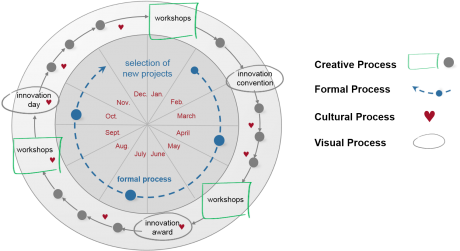
Implementing a culture of innovation
We differentiate between four diverse processes that facilitate to stimulate and release an organization’s potential of innovation, in order to establish a true culture of innovation within the company. The simple foundation of a research and development department, where innovation is outsourced is insufficient. Innovation should rather be a matter of course within all parts of the company.
The following figure illustrates all four processes partly integrated.

Within this process, peoples’ spirit and vigour of innovation are welcomed without any pressure to succeed or any expectations to meet a measurable goal. However, together we develop conditions to foster and promote creativity. There are specially-designed rooms for creative work. People are divided into groups across departments and corporate boundaries. A lot of innovation potential is based on this from everyday work uncommon combination of people. All participants receive some play money, which they can spend without any justification or formal approval. Here it is important to clearly separate creative processes from formal ones of the traditional project management.
The formal process
Within formal processes usual management approaches are used and therefore have to be strictly separated from the creative processes in time and organization. Ideas and proposals are structured, gathered, assessed and selected according to so-called “stage-gate-qualities”. The classical project management takes place within the formal process, where financial and sponsoring issues are addressed.
The cultural process
Whenever an organization chooses to define itself through their creativeness and innovativeness, these two characteristics have to be deeply rooted in the corporate culture. The responsibility to reach this goal is vested mainly in the hands of top management. It’s all about values and behavioural patterns of innovation that have to be a living commitment on the part of the management, or at least be approved and facilitated.
The visual process
The aim is to involve motivated employees within innovative projects, in a way that they can find access and stimulation in order to make their ideas visible. Such involvement especially includes the access to tools and techniques of the innovation management (brain writing, mind mapping, bionics etc.). It is important to apprehend the visual process less like a one-way information process but more like a bilateral conversation of information, discourse and dialogue. We would like to warn against the risk of overestimating electronic media. Often expectations are much higher than the success that they actually bring along. Examples of the visual process are: innovation fairs, innovation conventions or innovation awards.
The following figure illustrates all four processes partly integrated.

The four types of innovation processes
The creative processWithin this process, peoples’ spirit and vigour of innovation are welcomed without any pressure to succeed or any expectations to meet a measurable goal. However, together we develop conditions to foster and promote creativity. There are specially-designed rooms for creative work. People are divided into groups across departments and corporate boundaries. A lot of innovation potential is based on this from everyday work uncommon combination of people. All participants receive some play money, which they can spend without any justification or formal approval. Here it is important to clearly separate creative processes from formal ones of the traditional project management.
The formal process
Within formal processes usual management approaches are used and therefore have to be strictly separated from the creative processes in time and organization. Ideas and proposals are structured, gathered, assessed and selected according to so-called “stage-gate-qualities”. The classical project management takes place within the formal process, where financial and sponsoring issues are addressed.
The cultural process
Whenever an organization chooses to define itself through their creativeness and innovativeness, these two characteristics have to be deeply rooted in the corporate culture. The responsibility to reach this goal is vested mainly in the hands of top management. It’s all about values and behavioural patterns of innovation that have to be a living commitment on the part of the management, or at least be approved and facilitated.
The visual process
The aim is to involve motivated employees within innovative projects, in a way that they can find access and stimulation in order to make their ideas visible. Such involvement especially includes the access to tools and techniques of the innovation management (brain writing, mind mapping, bionics etc.). It is important to apprehend the visual process less like a one-way information process but more like a bilateral conversation of information, discourse and dialogue. We would like to warn against the risk of overestimating electronic media. Often expectations are much higher than the success that they actually bring along. Examples of the visual process are: innovation fairs, innovation conventions or innovation awards.
